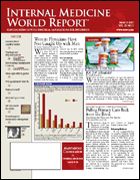Publication
Article
Internal Medicine World Report
WHO: First Guidelines for Prevention/Management of Avian Flu
Author(s):
The World Health Organization (WHO) has issued the first set of guidelines for the pharmacologic treatment of avian influenza A (H5N1) virus infection and for chemoprophylaxis in humans (Lancet Infect Dis. 2007; 7:21-31). Avian flu infection was reported in poultry in Hungary, England, and Russia. The H5NI virus was reported in 274 people so far, mostly in southeast Asia, 167 of whom died.
The guidelines focus on the management and prevention of sporadic H5N1 human infections and do not apply to a pandemic; they include the following recommendations:
• Patients with confirmed/strongly suspected H5N1 infection should be treated with oseltamivir (Tamiflu), although direct evidence for this suggestion remains sparse
• For antiviral chemoprophylaxis in high-risk groups, oseltamivir or zanamivir (Relenza) should be given for 7 to 10 days after the last known exposure.
Treatment
The recommendation for the use of oseltamivir for treating H5N1 infection in humans is based primarily on studies of adults with seasonal influenza that showed reduced respiratory tract complications and hospitalizations with oseltamivir. Even modest reductions in relative risk with oseltamivir, according to the panel of experts, could significantly lower the mortality rates from H5N1 infection.
Zanamivir has also been studied for the treatment of seasonal flu, but the data are insufficient to provide evidence for reduced mortality or shorter duration of hospitalization.
The M2 ion channel blockers amantadine (Symmetrel) and rimantadine (Flumadine) do not provide greater clinical benefits when used as first-line agents in H5N1-infected patients compared with oseltamivir and zanamivir, the panel noted. Antiviral resistance with amantadine or rimantadine was another reason to withhold support for these drugs.
Prevention
Oseltamivir and zanamivir are both strongly recommended for chemoprophylaxis. Chemoprophylaxis should be applied based on the following risk categories, which should help prioritize antiviral use when availability is limited, as well as prevent treating persons who are not at risk:
High risk • Household or close family contacts of a patient with strongly suspected or confirmed H5N1 infection
Moderate risk • Persons with unprotected and close or direct exposure to animals infected with H5N1 virus
• Healthcare workers in close contact with patients with strongly suspected or confirmed H5N1 infection
• Personnel involved in handling infected animals who may have used protective equipment improperly
Low risk • Healthcare workers not in close contact with, or who use appropriate protective equipment during exposure to, patients with H5N1 infection
• Personnel involved in handling infected animals who use appropriate protective equipment.
For chemoprophylaxis, oseltamivir and zanamivir should be continued for 7 to 10 days after the last known exposure in high-risk exposure groups. The level of recommendation for chemoprophylaxis with oseltamivir and zanamivir is less strong for those who are at moderate risk of exposure, because of the sparse evidence available in this population.
In settings where oseltamivir and zanamivir are unavailable, amantadine or rimantadine can be used as chemoprophylaxis against H5N1 in high or moderate-risk groups.
These guidelines may need to be revised if novel human influenza A viral subtypes emerge, the transmissibility of H5N1 to humans changes, and/or new drugs or data become available.
According to the WHO, 9 Asian countries, parts of Europe, as well as Russia and the Ukraine have reported outbreaks of infection with H5N1; some regions are limited to poultry infection and some include sporadic human infection. Although human-to-human transmission has not been documented, the potential for the H5N1 virus mutating to infect humans in large numbers, even a pandemic, has been a cause for serious concern.
The European Center for Disease Control reports that Europe is about 2 or 3 years away from being able to respond to a bird flu pandemic. The rest of the world still trails behind.
Key points
• Oseltamivir is recommended in patients with confirmed or strongly suspected H5N1 infection.
• Oseltamivir and zanamivir are both strongly recommended for use as chemoprophylaxis in high-risk exposure groups.






